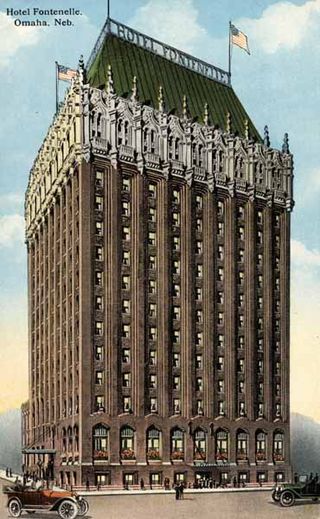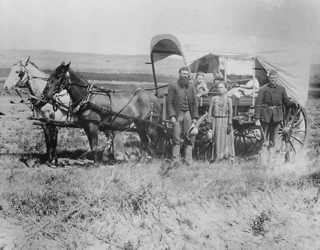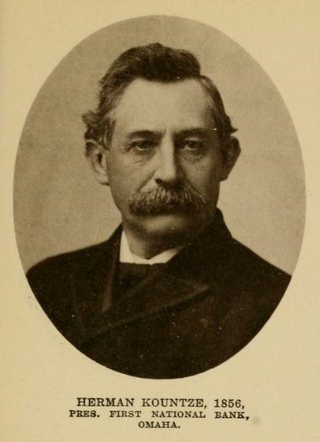Related Research Articles

Omaha is the most populous city in the U.S. state of Nebraska and the county seat of Douglas County. Omaha is in the Midwestern United States on the Missouri River, about 10 mi (15 km) north of the mouth of the Platte River. The nation's 40th-most populous city, Omaha's 2020 census population was 486,051.
East Omaha is a geographically designated community located in Omaha, Nebraska. Located three miles (5 km) from downtown Omaha, East Omaha is the site of Eppley Omaha International Airport, Omaha's main airport, and Carter Lake. This area was Omaha's first annexation, joining the city in 1854. Originally separated from Omaha by the Missouri River, a large section of the area's land was dissected by a ruling from the U.S. Supreme Court in 1892. Today, 2,500 houses, a school, grocery stores and a church that made up the original town have been demolished and replaced by several government facilities, the Eppley Airfield, and more.
Saratoga Springs, Nebraska Territory, or Saratoga, was a boom and bust town founded in 1856 that thrived for several years. During its short period of influence the town grew quickly, outpacing other local settlements in the area including Omaha and Florence, and briefly considered as a candidate for the Nebraska Territorial capitol. Saratoga was annexed into Omaha in 1887, and has been regarded a neighborhood in North Omaha since then.

The history of Omaha, Nebraska, began before the settlement of the city, with speculators from neighboring Council Bluffs, Iowa staking land across the Missouri River illegally as early as the 1840s. When it was legal to claim land in Indian Country, William D. Brown was operating the Lone Tree Ferry to bring settlers from Council Bluffs to Omaha. A treaty with the Omaha Tribe allowed the creation of the Nebraska Territory, and Omaha City was founded on July 4, 1854. With early settlement came claim jumpers and squatters, and the formation of a vigilante law group called the Omaha Claim Club, which was one of many claim clubs across the Midwest. During this period many of the city's founding fathers received lots in Scriptown, which was made possible by the actions of the Omaha Claim Club. The club's violent actions were challenged successfully in a case ultimately decided by the U.S. Supreme Court, Baker v. Morton, which led to the end of the organization.
The neighborhoods of Omaha are a diverse collection of community areas and specific enclaves. They are spread throughout the Omaha metro area, and are all on the Nebraska side of the Missouri River.
The Nebraska Territorial Legislature was held from January 16, 1855 until 1865 in Omaha City, Nebraska Territory.
Baker v. Morton, 79 U.S. 150 (1870), was the second of two land claim suits to come out of Omaha, Nebraska Territory, filed in September 1860, prior to statehood. A claim jumper filed suit against local land barons to stake out a homestead in the area that was to become the city of Omaha. The case was important for establishing homesteaders' rights and ensuring that the future growth of Omaha would benefit everyone, not just wealthy landowners and speculators.

The history of the U.S. state of Nebraska dates back to its formation as a territory by the Kansas–Nebraska Act, passed by the United States Congress on May 30, 1854. The Nebraska Territory was settled extensively under the Homestead Act of 1862 during the 1860s, and in 1867 was admitted to the Union as the 37th U.S. state. The Plains Indians are the descendants of a long line of succeeding cultures of indigenous peoples in Nebraska who occupied the area for thousands of years before European arrival and continue to do so today.

Herman Kountze was a powerful and influential pioneer banker in Omaha, Nebraska, during the late 19th century. After organizing the Kountze Brothers Bank in 1857 as the second bank in Omaha, Herman and his brothers Augustus, Charles and Luther changed the charter in 1863, opening the First National Bank of Omaha that year. Kountze was involved in a number of influential ventures around Omaha, including the development of the Omaha Stockyards and the Trans-Mississippi and International Exposition of 1898. Immediately after his death Kountze was regarded as one of Omaha's "old settlers". Today Kountze's First National Bank is the oldest bank west of the Mississippi River, and continues as a privately held company in its sixth generation of family ownership.
The Omaha Claim Club, also called the Omaha Township Claim Association and the Omaha Land Company, was organized in 1854 for the purpose of "encouraging the building of a city" and protecting members' claims in the area platted for Omaha City in the Nebraska Territory. At its peak the club included "one or two hundred men", including several important pioneers in Omaha history. The Club included notable figures important to the early development of Omaha. It was disbanded after a ruling against their violent methods by the U.S. Supreme Court in 1860 in Baker v. Morton.
Erastus A. Benson was a banker, investor and land speculator in Omaha, Nebraska. Born and raised in Iowa, after graduating from the University of Iowa Benson speculated in land around Omaha. After investing in early business ventures in the phonograph and the Kinetoscope, Benson staged an unsuccessful bid to become the Mayor of Omaha. In addition to being one of the inaugural members of the influential National Phonograph Association, the former town of Benson, Nebraska, was named after him.
Moses Franklin Shinn was a pioneer Methodist Episcopal Church minister in Omaha, Nebraska. Aside from founding Omaha's first cemetery, called Prospect Hill, he was also renowned for renouncing his Methodist affiliation in Keokuk, Iowa in order to remain a member of the Freemasons. The incident was probably the only of its kind ever to occur in the history of the Masons. Late in his life, Shinn was reportedly "one of the wealthiest citizens of Omaha".
William D. Brown was the first pioneer to envision building a city where Omaha, Nebraska sits today. Many historians attribute Brown to be the founder of Omaha, although this has been disputed since the late nineteenth century. Alfred D. Jones, the first postmaster of Omaha, laid strong claims to the title himself, suggesting that he told Brown about the potential for a town. Brown was also a member of the Second Territorial Legislature for the Nebraska Territory.
Crime in Omaha, Nebraska has varied widely, ranging from Omaha's early years as a frontier town with typically widespread gambling and prostitution, to civic expectation of higher standards as the city grew, and contemporary concerns about violent crimes related to gangs and dysfunctions of persistent unemployment, poverty and lack of education among some residents.

Alfred D. Jones was a late 19th-century lawyer, surveyor and politician in the Midwestern United States. In 1846 he platted Fort Des Moines, Iowa, and in 1854 he platted Omaha, Nebraska. He became the first settler in Omaha, as well as the first postmaster, a member of the first Omaha City Council and the first Omaha School Board, and was among the first legislators of the Nebraska Territory.
Credit Foncier of America was a late 19th-century financing and real estate company in Omaha, Nebraska. The company existed primarily to promote the townsites along the Union Pacific Railroad, and was incorporated by a special act of the Nebraska Legislature in 1866. Credit Foncier was said to be "intimately connected with all the early towns along the Union Pacific."
The Irish in Omaha, Nebraska have constituted a major ethnic group throughout the history of the city, and continue to serve as important religious and political leaders. They compose a large percentage of the local population.

Native American tribes in the U.S. state of Nebraska have been Plains Indians, descendants of succeeding cultures of indigenous peoples who have occupied the area for thousands of years. More than 15 historic tribes have been identified as having lived in, hunted in, or otherwise occupied territory within the current state boundaries.
Enos Lowe was a pioneer doctor and businessman who was among the original founders of Omaha, Nebraska, and served as president of the Second Iowa Constitutional Convention.
Significant events in the history of Omaha, Nebraska, include social, political, cultural, and economic activities.
References
- ↑ Bogue, A. (1958) "The Iowa Claim Clubs: Symbol and Substance", The Mississippi Valley Historical Review, 45(2). September. pp. 231
- ↑ Pelzer, L. (1936) The Cattlemen's Frontier. Glendale, CA: AR. Clark. p. 87.
- ↑ Hogan, R. (1987) "Carnival and Caucus: A Typology for Comparative Frontier History", Social Science History, 11(2). Summer. p 147.
- ↑ Southwestern Social Science Association (1968) Social Science Quarterly, University of Texas. p. 21.
- 1 2 Dilke, C.W. (2005) Greater Britain: A Record of Travel in English-Speaking Countries During 1866 and 1867. Cosimo, Inc. p. 167.
- 1 2 (nd) "Tidricks in Nineteenth Century America" Archived 2007-09-30 at the Wayback Machine . Retrieved 7/19/07.
- 1 2 Boorstin, D. (1967) The Americans: The national wide experience. pp. 73-78.
- ↑ Clark, D.E. (1937) The West in American History. Thomas Y. Crowell Company. p. 321.
- ↑ History of Nebraska from the Earliest Explorations of the Trans-Mississippi Region. Lincoln, NE: Western Publishing and Engraving Company. p. 188. Retrieved 7/15/07.
- ↑ Rister, C.C. (1947) Western America: The Exploration, Settlement, and Development of the Region Beyond the Mississippi. Prentice-Hall, Inc. p. 307.
- ↑ Gunn, LaDonna; Hughes, Dave (2009-01-11). "Early Forms of Civil Justice: The El Paso Claim Club (1859-1862)". history.oldcolo.com. Retrieved 2023-11-29.
- ↑ (nd) "Cañon City, Colorado" Archived 2007-06-08 at the Wayback Machine . Retrieved 7/18/07.
- ↑ Loyola, M. McNally, M.C. and McGill, E.L. (1922) The Opening of Iowa to Settlement and Its Development During the Territorial Period. University of California. pp. 51-53.
- ↑ Morton, J. and Watkins, A. (1918) "Nebraska Claim Meeting," History of Nebraska from the Earliest Explorations of the Trans-Mississippi Region. Lincoln, NE: Western Publishing and Engraving Company. p. 188. Retrieved 7/15/07.
- ↑ (nd) "History of Sarpy County", Andreas' History of the State of Nebraska. Retrieved 7/13/07.
- ↑ (2007) "Bellevue Settlers Club," [usurped] Nebraska State Historical Society. Retrieved 7/18/07.
- ↑ (nd) "History of Dodge County" Archived July 17, 2006, at the Wayback Machine , Andreas' History of the State of Nebraska. Retrieved 7/13/07.
- ↑ Hafen, L. (1952) "Fort St. Vrain," The Colorado Magazine, XXIX(4). Retrieved 7/19/07.
- ↑ Swierenga, R. (1968) Pioneers and Profits: Land Speculation on the Iowa Frontier. Iowa State University Press. p. 15.
- ↑ (2007) "Des Moines Center Manuscript Collection," State of Iowa. Retrieved 7/18/07.
- ↑ Robinson, D. (1925) Doane Robinson's Encyclopedia of South Dakota. University of California. p. 822
- ↑ Newfon, D.E. (1948) The Dixie Frontier: A Social History of the Southern Frontier. A.A. Knopf, Publishers. p. 69.
- ↑ Lester, W.W. Decisions of the Interior Department in Public Land Cases and Land Laws Passed by the Congress. United States Department of the Interior, United States General Land Office. p. 393.
- ↑ United States Supreme Court. (1912) "Baker v. Morton", United States Supreme Court Reports. Lawyers Co-operative Publishing Company. p. 150-159.
- 1 2 Sorenson, A. (1874) "Chapters XIV - XVII: Early history of Omaha" Archived 2007-06-26 at the Wayback Machine , Early History Of Omaha; or Walks And Talks Among The Old Settlers: A Series of Sketches in the Shape of a Connected Narrative of the Events and Incidents of Early Times in Omaha together with a Brief Mention of the Most Important Events of Later Years. Omaha Bee Publisher. p. 110. Retrieved 7/14/07.
- ↑ Larsen, L. and Cottrell, B. (1997) The Gate City: A History of Omaha. University of Nebraska Press. p. 43.